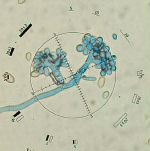Mold Investigation and Management
Mold, Bioaerosol & Moisture Investigations
We start investigations with a visual inspection for signs of mold and excessive moisture or water intrusion. Our investigators address water intrusion, mold, and associated indoor air quality issues. We strive to examine all aspects of the problem, from the construction or design condition that allows the water to intrude, to the resulting moisture levels of various building components, to the detection and identification of molds and fungi.

Indoor Environment Group employs a combination of sophisticated techniques and state of the art equipment to investigate sources of mold and bacterial growth and their byproducts, in addition to other bioaerosols, such as animal and insect allergens.
Examples of common tests include:
- Viable Sampling - culturable mold and bacteria in air
- Non-Viable Sampling - air sampling for non-viable particles
- MVOC Sampling - microbial volatile organic compounds
- Surface Sampling - wipes, swabs, contact or tape lift samples
- Bulk Sampling - building materials, dust, debris, etc
- Water Samples - Legionnella
- Particle Identification - allergens, fibers, dust mites, animal dander, insects
- Infrared Thermography
- Moisture Testing
We then provide you a comprehensive report upon completion of our investigation. In the report we address hazards associated with mold, which is a critical step in assessing risk, because the mere presence of microorganisms does not constitute a human health hazard. We will also outline the services provided, the specific findings and our recommendations for both eliminating any existing problems identified and for preventing future problems.
Mold Remediation Clearance Testing
Finally, Indoor Environment Group can develop and implement clearance testing and follow-up monitoring programs to prevent future problems and to ensure that affected areas were properly addressed.
Our clearance investigations are designed to ensure that remediation activities have been successfully completed and that the risk of regrowth is minimal. Investigation are usually a two step process:
First, our inspector will conducted a visual inspection each work area. During the visual inspection we look for signs of remaining microbial growth, conditions that may contribute to future microbial growth, evidence of satisfactory disinfection work, general cleanliness of the work areas and for confirmation that the scope of work has been completed as per agreement with the client.
The second step is the sampling phase. In general, two sampling methods are available, air and surface sampling.
With surface sampling, surfaces in the work areas are selected based on the level of cleaning difficulty, the level of pre-remediation contamination and/or the likelihood of remaining microbial contamination. In most cases, four to ten surfaces were targeted for sampling. At each of these locations a swab sample is collected using a Hygiena Ultrasnap ATP swab. After collection, the swabs prepared according manufacturer specifications and loaded into an ATP analyzer and the results recorded onsite.
The ATP monitoring systems utilize a luminometer to measure the level of ATP (adenosine tri-phosphate) bioluminescence present within the swab sampler. ATP is present in all living organic material including mold. Accordingly, microorganisms are detected by the technique but also detected are other organic residue such as bacteria, yeasts, bio-film, somatic cells, etc. The results are presented in RLU (relative light units) which do not necessarily correlate to conventional CFU measurements but rather indicate the cleanliness of the surface and the potential for pathogens or unhygienic surfaces.
Air sampling is the other sampling option. Samples are collected from inside the work areas and one sample is collected outside for comparison purposes. Air samples are collected using non-viable sampling cassettes which collect particulate matter for analysis by impacting the individual particles onto a sticky glass slide contained within the housing of the cassette. After collection, the cassettes are submitted to the lab for microscopic analysis.
Indoor Environment offers four standard options for microbial remediation clearance:
- Standard Clearance - Visual Investigations - Includes visual inspection and moisture testing of the work area and provides clearance certification on site upon successful completion. Great for small areas where all contaminated materials have been removed.
- Standard Clearance with air sampling - Standard Clearance investigation with non-viable microbial air sampling.
- Standard Clearance with surface sampling - Standard Clearance investigation with surface sampling. This option provides us a with an immediate determination regarding the cleanliness of the remediation area. Surface samples are collected and analyzed on site using ATP analysis methods.
- Full Clearance - Standard Clearance investigation with air and surface sampling. This option includes in the collection of surface and non-viable air samples.
Our standard mold clearance investigations include the following services:
Visual inspection - a surface by surface investigation that looks for signs of fungal growth, water damage, dust or debris. We also ensure that surfaces have been treated with the appropriate solutions where applicable.
Moisture testing - we check all exposed surfaces and adjacement materials to ensure that moisture levels are low and ready for re-construction activities.
Microbial sampling - collection of air and/or surface samples to determine mold levels in the work area. Outdoor samples are collected for comparison. Most air sampling involves the collection of non-viable samples to allow for quick laboratory turnaround although viable samples can be collected if requested.
Clearance certification is provided only if all phases of the investigation meet our standard clearance criteria or project specific requirement. Verbal confirmation of clearance is usually available within 24 hours of sample collection (non-viable) with written confirmation within an additional 24 hours. Confirmation on viable sample analysis may take up to 12 days from sample collection.
Residential Mold Investigations - Indoor Environment can also help you identify mold problems in your home. Please click here to visit our Residential Mold Investigations Page.

